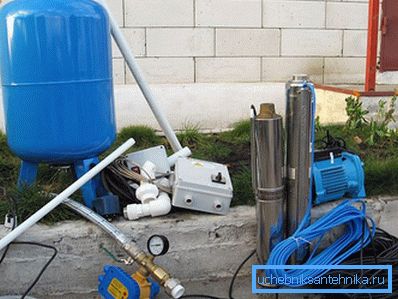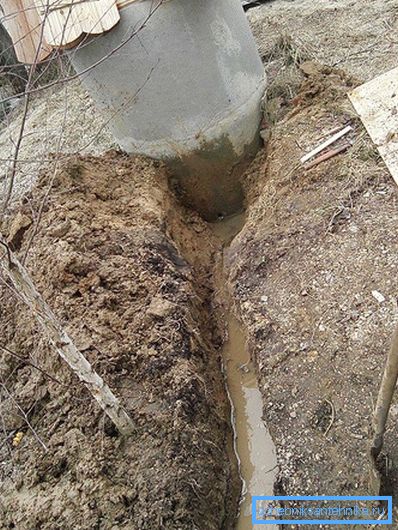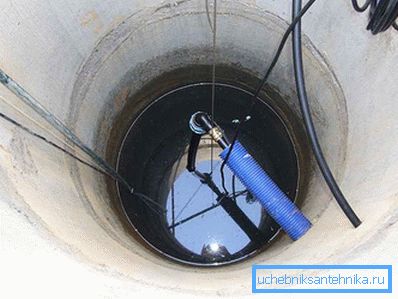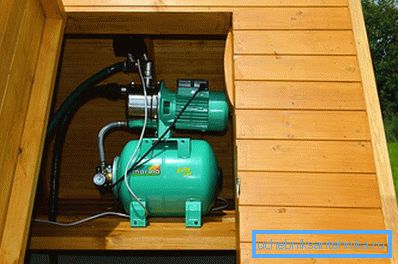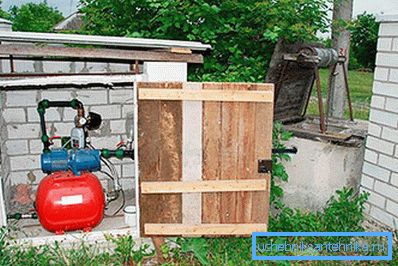How to draw water to a house from a well
It is difficult to imagine a modern country house without water supply, but it is not always possible to provide a house with water from a centralized water supply system. As a source of water supply, in the absence of a centralized water supply system, there may be a well or a well. A well is an expensive pleasure that not everyone can afford; a well, on the contrary, is the simplest and most accessible source of autonomous water supply. After the well is dug, the task is how to draw water into the house from the well.
Choosing a water pump
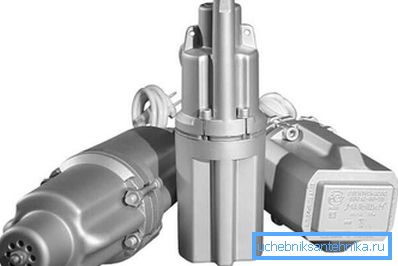
First you need to determine the type of pump through which water will be fed into the house. Water supply from the well can be organized by two types of pumps:
- using individual centrifugal pumps, which can lift water from a depth of 8 m, in some models (ejector stations) the suction depth is increased to 45 m, but such stations are very capricious in operation and cost much more expensive;
- using a submersible pump that is installed in the well.
What type of pump to use depends on the water level in the well and the seasonality of its fluctuations. If, according to observations, in the dry period, the water level in the well falls below 8 m, then it is better to be safe and install a submersible pump, fixing it in the well on the cable. The pump should be installed above the bottom of the well by 0.5 m. The performance of the submersible pump is selected not only for water consumption, but also for the flow rate of the well: the pump performance must be less than the flow rate of the well, but in any case the pump must be equipped with a dry-running sensor.
Pipeline laying
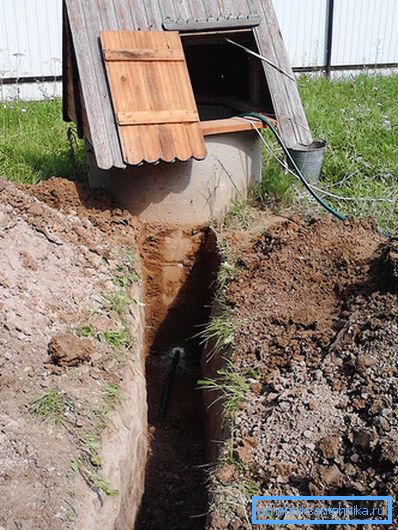
From the well a trench is being dug, the bottom of which should be below the depth of soil freezing. If it is difficult to dig a trench of such a depth, then the pipeline will need to be insulated or a heating cable laid along it.
The hole through which the water supply system is put into the well, after the laying of the pipeline, must be sealed with cement-sand mortar or assembly foam.
Particular attention should be paid to the installation of the suction pipe, if a surface pump is used to supply water. The diameter of the pipeline should always be greater than the diameter of the pressure pipe, as a rule, not less than 32 mm. When laying the suction pipe to a private house from a well, it needs to give a slope of at least 0.01 ° to the water intake in order to avoid air accumulation and air traffic jams. You should not lengthen the suction line, and in the case when the suction height is close to 8 m, the length should not be more than 3 m. Errors in the installation of the suction line can cause your pump to fail to raise the water or may fail due to cavitation.
At the end of the suction pipe that falls into the well, a check valve and a strainer must be installed, the pipe should not fall below 25–30 cm to the bottom of the well so as not to suck silt and sand into the system.
Water supply circuit with a hydroaccumulator
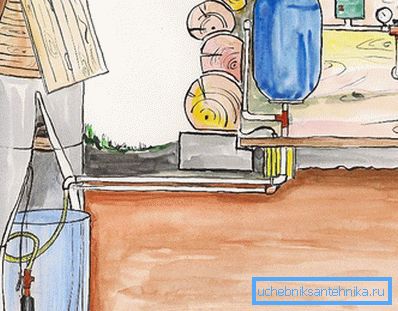
The most common scheme of water supply from a well is the use of an automatic water supply pumping station. This station consists of a centrifugal pump, a hydroaccumulator and a pressure switch equipped with a pressure gauge. A pumping station is usually installed in the basement of the house, but if the distance from the well to the house exceeds 15 m, the pumping station will have to be installed near the well, in a pit that can be mounted from brick or increased the diameter of the suction pipe.
The pit must be insulated and equipped with ventilation.
Pumping stations, as a rule, are equipped with a hydraulic tank with a capacity of no more than 50 liters, if, according to calculations of this volume, the hydraulic tank is not enough, it can be replaced with a larger one.
It is not necessary to install the hydroaccumulator near the pumping station, but its installation can be carried out in a house, in a technical or basement room and immediately install a pressure switch. Care must be taken to install a fine filter in front of the pump (on the suction line) to protect the pump impeller from sand.
Before starting the pump, the suction line must be checked for tightness - it must always be filled with water.

An alternative to the accumulator can be a circuit with the installation of an electronic controller for the pump. The design of this device includes flow and pressure sensors that are connected to the electronic circuit, pressure gauge and check valve. This device automatically controls the pump, including it immediately at the beginning of water consumption, and turns off the pump at the end of the water analysis. Also protects the pump from idling or when there is a shortage in the suction pipe. This device has a limitation, it is not installed on pumps with a capacity of more than 10 m3/ hour, the maximum working pressure is 10 bar, the system must also be absolutely tight, the minimum flow of water will constantly turn on the pump. When using an electronic regulator, there is no need for a hydroaccumulator, if a surface pump is used, for a submersible pump you need a hydraulic tank with a capacity of 20 liters, another big plus of this device is to maintain the same pressure in the system, regardless of water consumption.
The electronic regulator is connected directly to the discharge port of the surface pump or, in the case of using a submersible pump, crashes into the pressure pipe before the hydraulic tank.
Well water quality

Given that the wells are usually planted on aquifers, which are poorly protected, the water in them may not correspond to the quality shown to drinking water. In order to be able to drink water from the well, you need to take care of additional cleaning.
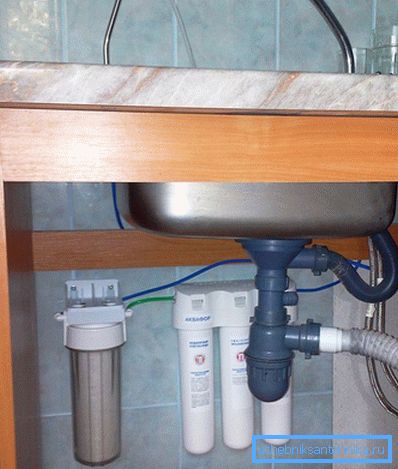
The type of cleaning should be selected after analyzing the water, it may be enough to install a three-stage cleaning based on carbon filters that are installed under the sink.
Video
Watch the video about laying the water supply from the well to the house:
Scheme
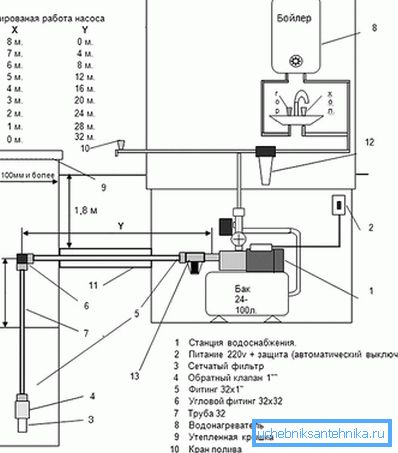
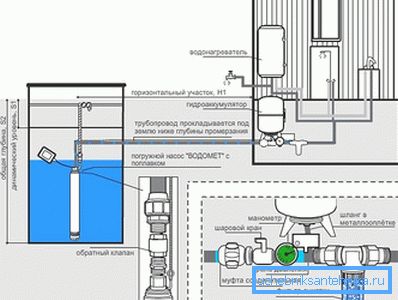
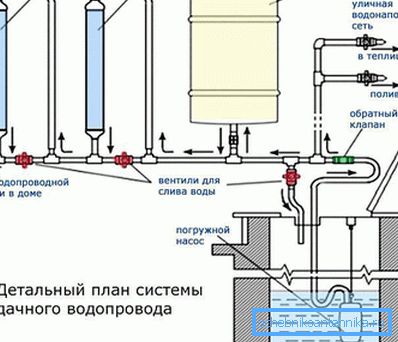
A photo
